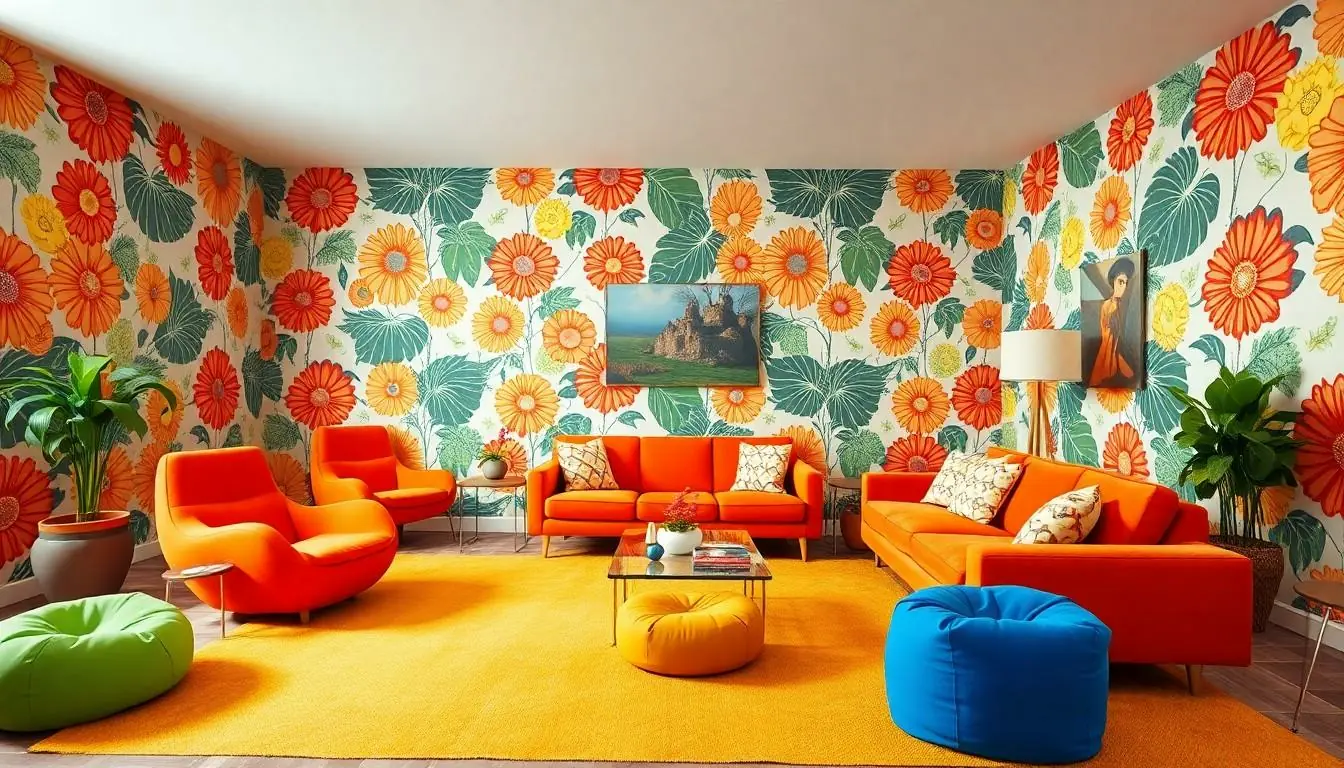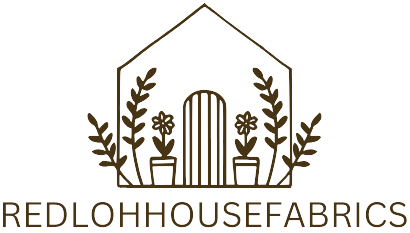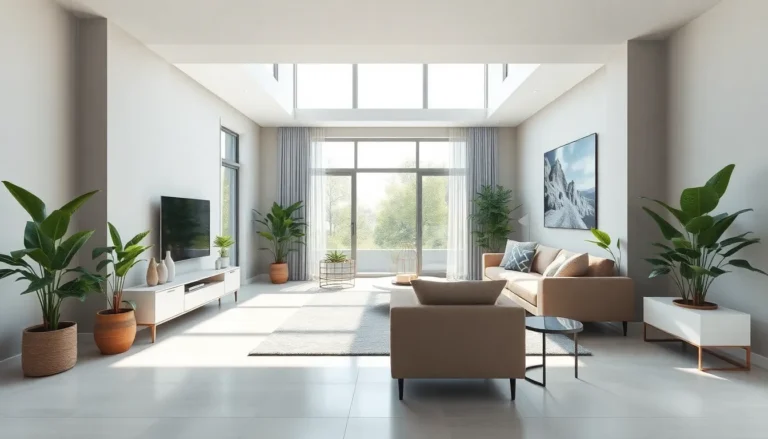Table of Contents
ToggleStep into a time machine and zoom back to the 1960s, an era where bold colors and funky patterns ruled the roost. If you think avocado green and burnt orange should only be found in salads, think again! This decade transformed interior design into a playground of creativity, where anything was possible and “less is more” was tossed out the window faster than a lava lamp could bubble.
Overview of 1960s Interior Design
The 1960s marked a radical departure from previous design aesthetics. Bold colors and eclectic patterns emerged, shaping living spaces with a vibrant energy. Designers favored statement pieces, often choosing large, graphic artworks to dominate walls.
Furniture styles included both organic and geometric shapes, reflecting a willingness to experiment. Modular designs allowed for flexibility and adaptability, catering to the dynamic lifestyles of the time. The use of materials like fiberglass, plastics, and metals contributed to a modernist feel.
Spaces often featured open floor plans, facilitating both movement and social interaction. Textiles with psychedelic prints and rich textures enhanced visual appeal. Earthy tones balanced bold shades, creating inviting atmospheres in homes.
Lighting took on sculptural forms, serving as artistic statements while providing illumination. Iconic pieces, such as the globe pendant lights, became synonymous with the era. Bright hues and innovative designs spread to kitchens and bathrooms, pushing boundaries across all spaces.
The integration of technology also played a crucial role, as furniture and decor embraced accessibility and ease. Units designed for compact living responded to urbanization trends. Nature-inspired elements, from botanical wallpapers to rustic finishes, conveyed a connection to the outdoors.
1960s interior design thrived on creativity and bold choices. Its legacy influences contemporary design, as the emphasis on individuality continues to resonate in modern homes.
Key Characteristics of 1960s Interior Design

1960s interior design features bold colors and innovative styles. The era emphasized playful expression and creativity, making it distinct from previous decades.
Color Palettes
Bright color palettes defined the 1960s aesthetic. Shades like orange, avocado green, and yellow became popular, often used in unexpected combinations. Contrasting hues created vibrant spaces, while earth tones, such as browns and muted greens, offered balance. Accent colors appeared in furniture, textiles, and wall decor, enhancing visual interest. For instance, large-scale wallpaper patterns often showcased these vivid colors, transforming entire rooms. The use of lacquer finishes and glossy materials added to the modern feel, forging a dynamic interplay between color and texture.
Furniture Styles
Furniture styles in the 1960s embraced both organic and geometric forms. Unique chairs and sofas showcased sculptural lines and playful silhouettes, attracting attention in any living space. Designers like Eero Saarinen and Charles Eames produced iconic pieces, combining functionality and art. Modern materials such as plastics, fiberglass, and metals replaced traditional woods, enabling new shapes and finishes. Vintage pieces often featured low profiles, supporting the open floor plan trend. Accent furniture, such as bean bags and pop art-inspired seating, added a fun touch that fostered casual, relaxed atmospheres.
Influential Designers of the 1960s
The 1960s showcased remarkable designers who left a lasting mark on interior aesthetics. Notable figures from this era embraced innovation and creativity.
Iconic Pieces and Innovations
Eero Saarinen created the Tulip Chair, characterized by its smooth, sculptural form. Charles Eames produced the Eames Lounge Chair, merging comfort with modern design principles. Richard Meier introduced the classic furniture lines emphasizing geometric simplicity. Verner Panton designed the Panton Chair, notable for its bold colors and unique shape. These iconic pieces contributed to a lively yet functional atmosphere. Innovative materials like fiberglass and molded plastic gained popularity, allowing for new design possibilities. Designers frequently incorporated bright palettes combined with organic shapes, transforming living spaces into vibrant retreats. Each piece reflected the era’s spirit, encouraging exploration and experimentation in interior decor.
Impact of Cultural Shifts on Interior Design
Cultural shifts in the 1960s greatly influenced interior design trends, shaping aesthetics and functionality in homes.
The Role of Technology
Technology transformed how people approached home decor during the 1960s. New materials like molded plastics and fiberglass enabled designers to create innovative furniture that was both stylish and functional. Compact living became popular due to technological advancements, as space-saving solutions emerged. Designers embraced affordability and adaptability, reflecting a modern lifestyle. Innovations such as modular furniture allowed for personal customization, enabling flexibility in home layouts. Electric lighting also evolved, with eye-catching designs like globe pendants becoming essential features in many homes. Altogether, these technological advancements encouraged a playful interaction between functionality and artistic expression.
Influence of Pop Culture
Pop culture significantly impacted interior design choices in the 1960s. The rise of vibrant music movements and the youth culture led to bold color palettes and eclectic patterns in home decor. Iconic figures like The Beatles and artists from the counterculture inspired designs featuring psychedelic prints and adventurous motifs. Television shows showcased modern aesthetics, further popularizing contemporary styles to a broad audience. Movie sets also influenced design trends, as films depicted revolutionary styles that homeowners desired to replicate. As a result, spaces reflected the era’s cultural dynamism, blending artistry with everyday living.
The 1960s remain a defining era in interior design that celebrates creativity and bold expression. Its vibrant colors and eclectic styles continue to inspire modern decor, encouraging individuals to embrace their unique tastes. Iconic pieces and innovative materials from this decade not only transformed living spaces but also laid the foundation for contemporary design principles. The blend of functionality with artistic flair invites a sense of playfulness that resonates today. As homeowners seek to reflect their personalities through decor, the spirit of the 1960s lives on in countless modern interiors.


